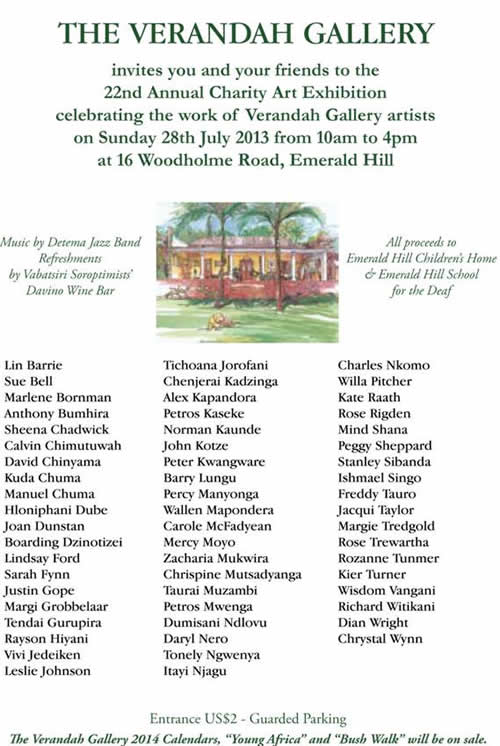Buy some art, support charity
Thursday, July 18th, 2013 by Bev Clark
Kubatana.net ~ an online community of Zimbabwean activists
After the signal blackout by the South African Broadcasting Corporation the free to air decoders acquired by most Zimbabweans are now symbolic and a reminder of what used to be an alternative source of entertainment. Recently I was watching a debate on ZBC’s “Melting Pot” and I expected to see a pot really melting with some lively debate but my expectations were a bit high. The debate turned out to be a rehearsed and a one sided event with in-between citation of a certain political party’s manifesto which I am sure by now viewers can now sing every word by heart. The show anchor actually did not even shy away from showing his party allegiance to an extent that one would have mistook him for a campaign manager of a certain political party. My previous dealing with shows like these would be remote in hand, flipping channels on my free to air decoder or settling my dollar for two movies from the streets.
I am not alone in this fix. The signal cut off by SABC has affected Zimbabwe’s generation of young viewers who had fallen in love with dramas and soaps from down south. Our own local production companies tried to lure young audiences with locally produced dramas and soap operas but the story line ended up getting tired and boring like the actors. The recycling of the usual actors was a big turn off to young viewers especially when our local television is competing with the youth targeted and fast paced programming from SABC and other digital satellite broadcasting stations. The reason why most Zimbabweans preferred to invest in the free to air decoders is they got tired of Zimbabwe Broadcasting Corporation’s programming and monopoly of the airwaves. Also DSTV subscriptions are just too exorbitant. How to do you expect to compete for viewers when programs like “Madzinza eZimbabwe” and some Korean documentaries with subtitles are aired during prime time viewing when SABC offers programs like Isidingo and Generations? Neither would one expect to watch a repeat of ‘Talking Farming” after a long day at work.
But since I’m still searching for an the alternative here is my Friday prime time fix from ZBC-TV & Channel 2:
1730-1830 – NHAU/INDABA
1830-1930 – WOZA FRIDAY
1930-1931 – NEWS HEADLINES
1931-2000 – REVELATIONS
2000-2100 – NEWS HOUR
2100-2115 – ZANU PF – THE MANIFESTO
2115-2145 – MA 1 EP 03
2145-2300 – FRIDAY NIGHT ACTION MOVIE:
2300-2315 – LATE NIGHT NEWS
2315-2330 – ACTION MOVIE (CONTINUATION)
2330-0000 – MY WIFE AND KIDS
0000-0100 – DOCUMENTARY
0100-0400 – IN CONCERT
0400-0530 – MOVIE: PLEASURE PALACE
0530-0555 – SINJALO EP 11
No Laughing Matter? : Humor And Protest Arts
Deadline: 30 July 2013
The University of Zimbabwe and Savanna Trust invites you to submit your abstracts for conference presentations on the 24th and 25th of October 2013 in Harare, Zimbabwe.
In both popular and academic imagination, protest arts have been generally associated with ‘angry’ and ‘gloomy’ ‘subversive’ images. Consequently limited attention has been paid to the use of humour in protest arts. The possibilities, complexities and limitations of humour in protest arts deserve serious recognition. Several questions can be raised in this regard. Why in the first place do artists and the public include humour in their protest arts? Is humour compatible with radical transformative protest arts? What are the aesthetic and ideological implications of deploying humour in protest arts? How have state actors, elites and the general public responded to humour in protest arts?
Sub-Themes
-Aesthetic quality, humour and protest arts
-Ideological possibilities/complications of humour in protest arts, (eg gender, class, race, ethnicity disability political identity etc)
-The reception of humour in protest arts
-Humour, ethics and morality
-Writing/performing humour in protest arts
-Media/technology, humour and protest arts v Protest music and humour
-Humour in protest marches and demonstrations
-Humour in protest and graffiti
-Popular jokes and/as protest arts
Submit your abstracts in not more than 350 words to: kchikonzo [at] arts [dot] uz [dot] ac [dot] zw and copy paifst [at] gmail [dot] com
Ever since the day I watched a documentary called Wasteland on how a photographer changed the lives of rubbish pickers in Brazil by empowering them to make art with the recyclable materials they pick from the dump site my mind now forever boggles on how best people can make of the circumstances and scenarios they are in. The Friendship Bench at Harare Hospital is one of the many ideas across the country of how communities are being empowered.
I recently visited the Friendship Bench at Harare Hospital. An organisation created by Dr Chibanda to assist low-income people suffering from depression and anxiety. Patients come to the wooden bench for counselling from trained health workers. After realising that most of the people receiving counselling at the Friendship Bench had no source of income, the idea of Zee Bags was born. These women crotchet old plastic bags into colourful shopping baskets and fun handbags.
Now the women have been so empowered to make their own living. If you attended HIFA this year, you probably saw their stand, which was big and eye-catching. Being at HIFA and exhibiting was a great achievement for them and now they look forward to doing the same at the Harare Agricultural Show.
Being around this group of women you can see how this community development project has helped them to deal with their challenges with common mental disorders, depression and anxiety. During the interviews I gathered most of the women eluded that before joining this project all they could think of were their worries leading to stress, but now making these bags keeps their minds busy. And it’s also giving them some income to take care of their families.